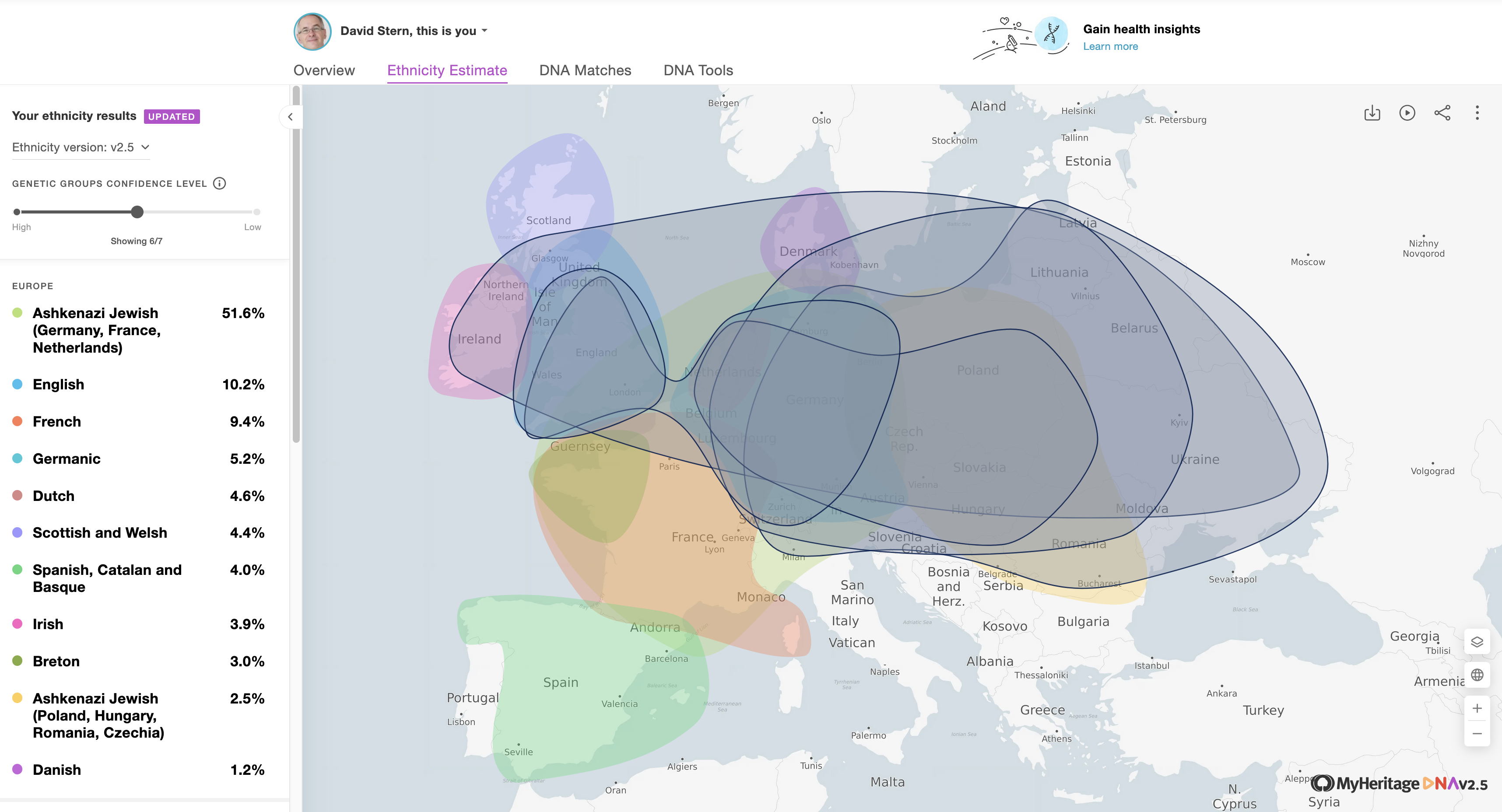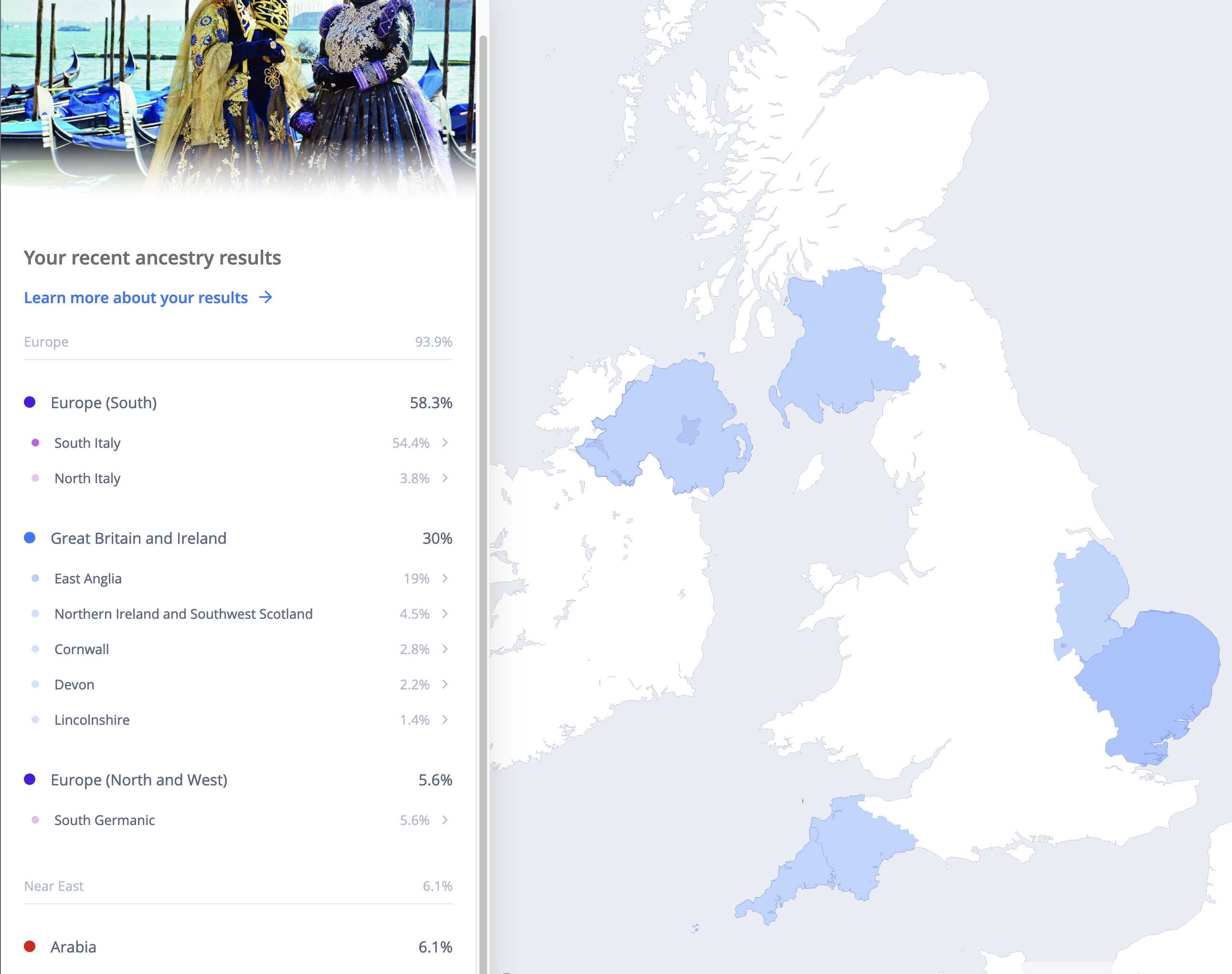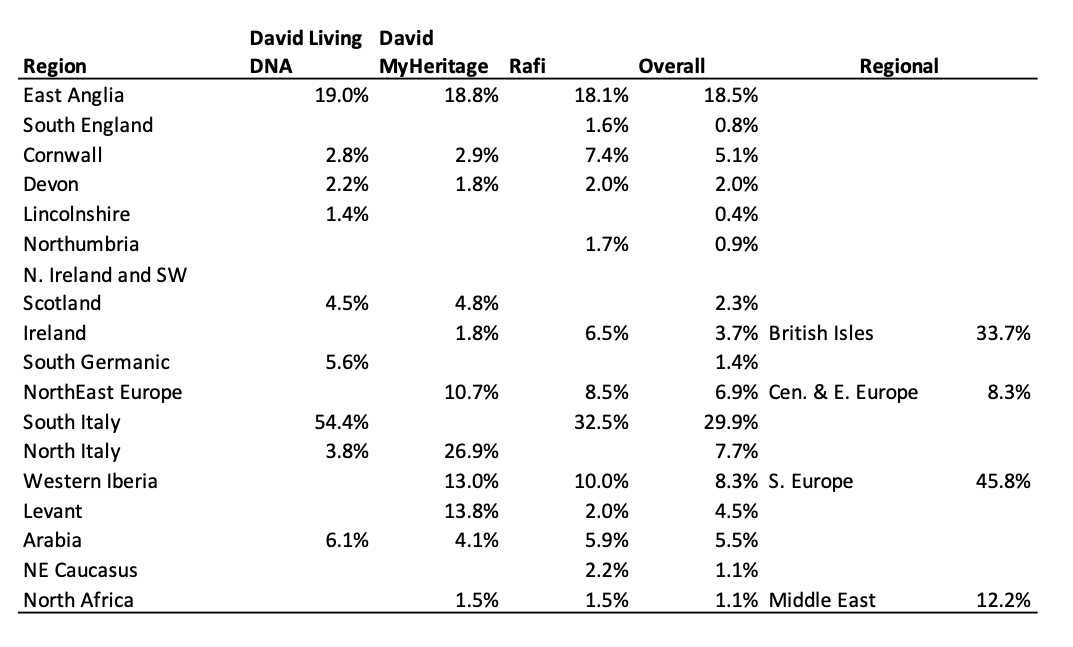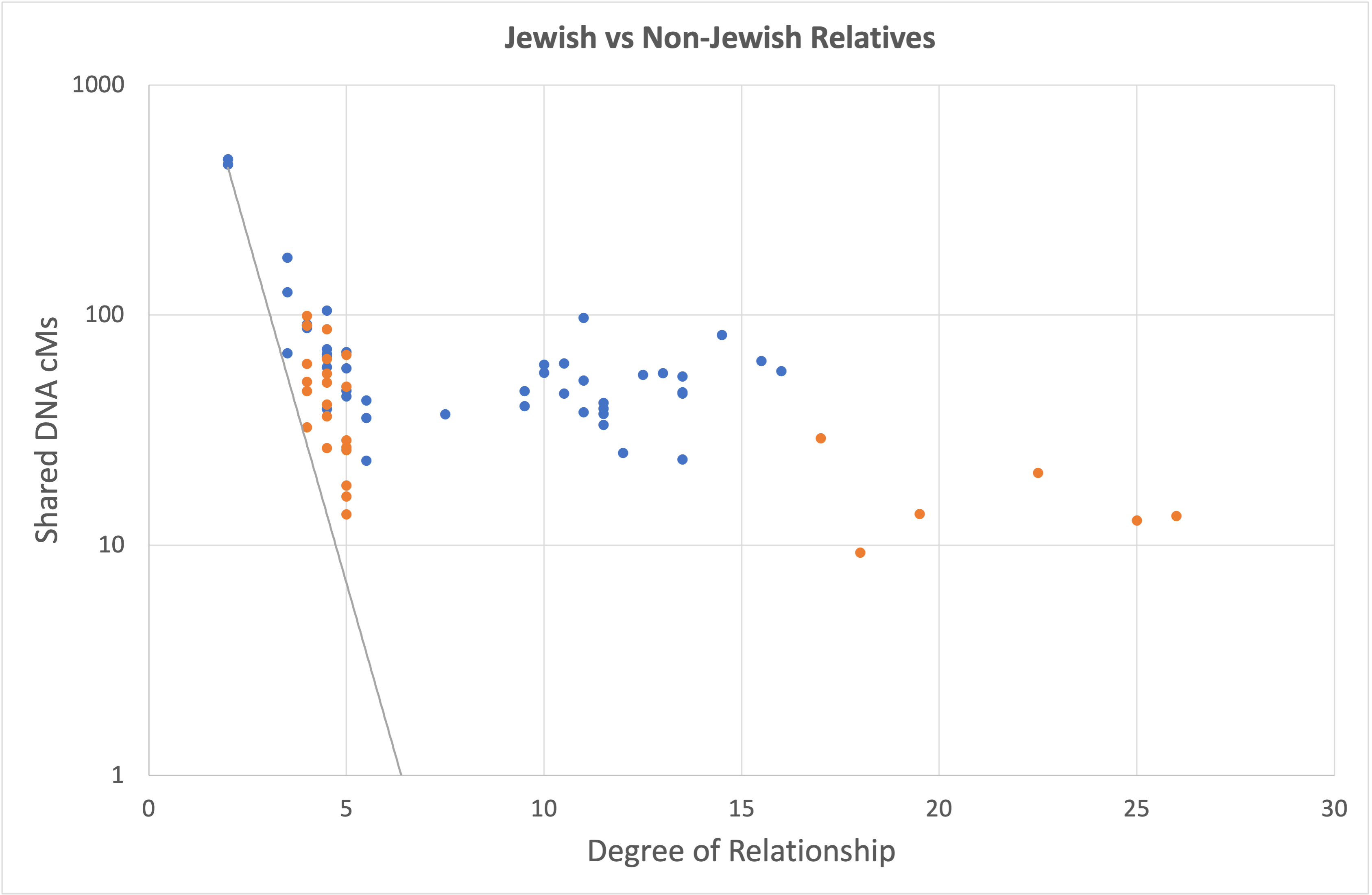In the following analysis, remember that a parent should contribute exactly 50% of their child's DNA, a grandparent approximately 25%, a great-grandparent is expected to contribute around 12.5% of a descendant's DNA, and a great-great-grandparent about 6.25% etc. While you should have exactly 50% of each parent's DNA, the shares you receive from earlier ancestors can vary from these average predictions. Of course, all the results below are subject to change as new analyses become available!
Ruth Leah's sons David and Rafi both did DNA tests with MyHeritage. David also did a test with LivingDNA.[1] LivingDNA is based in the UK and specializes on ancestry from individual UK regions. MyHeritage is an Israeli company and so it has a lot of Jewish users - so we might expect that its analysis in that area is relatively accurate. Both are swab tests, which are the easiest to do.[2] This map shows the results of David's MyHeritage test:

These results are from MyHeritage's new v2.5 model. Results from their previous model predicted that David had 62% and Rafi 57% Ashkenazi ancestry. But these results show that he has 53.9% Jewish ancestry, while Rafi has 53.4%. Based on known ancestry, we would predict that David and Rafi both are 50% Ashkenazi Jewish. The rest of the breakdown is obviously nonsense with only 10% English ancestry.[3] LivingDNA provide the following breakdown for David:

We ran both David and Rafi's MyHeritage results through LivingDNA as well. Summarizing David and Rafi's analyses from Living DNA:

LivingDNA does not compare DNA to a Jewish sample, and so Ashkenazi Jewish heritage is matched to Southern Europe and various Middle Eastern regions.[4] The total of these ancestries is 58%. Drilling down into the 34% from the British Isles, we know that David and Rafi's great-grandmother Emily Ruth Woodward's (12.5%) parents came from London, though her grandfather Thomas Elliott's family came from North Yorkshire (3.125%). David and Rafi's great-grandmother Florence Maude Jordan's mother Jane Davis was from Cornwall (6.25%) and her father William Jordan from Berkshire. William's father said he came from Yorkshire (3.125%), while his mother, Emma Maria came from Berkshire (3.125%). So, we expect 12.5% from South-East England, 6.25% from Cornwall, and 6.25% from Yorkshire. In LivingDNA's results, Cornwall and Devon sum to 7% and East Anglia, which borders London, contributes 18.5% with another 0.8% from Hampshire and Dorset. Perhaps the 1.3% from Lincolnshire and Northumbria is the match for William Jordan senior's and Thomas Elliott's Yorkshire ancestry. Cornwall and Devon have fairly distinct ancestry within England, but the other regions are more homogenous.
What about David and Rafi's two great-grandfathers William Browne and Thomas Ambrose? We discovered William's family through DNA matching. William (12.5%) seems to have been a protestant from County Cork in Southern Ireland, so his DNA would likely be similar to people from Southern Scotland or Northern Ireland, though some of his ancestors seem to be Welsh. Protestant settlers are the majority in Northern Ireland but a small minority today in Southern Ireland. Here we find a total of 6% for Scotland and Ireland. The analysis also returned an average 6.9% for Northeast Europe (Poland, Ukraine, and Belarus). This could reflect the Northern European ancestry introduced by Jews who migrated into the area of the Czech Republic in the early Middle Ages. So, this together with the Southern Germany signal would seem more likely to go into the Ashkenazi basket. We can see the signal for William Browne, but it is weaker than we might expect.
So, we are left with 3.7% excess Jewish ancestry according to MyHeritage or much more than that according to LivingDNA. We also have one remaining great-grandparent who should have contributed 12.5% of the total ancestry. We concluded that nothing about Thomas Ambrose's story made sense. He variously stated that he was from England or Brisbane. There were Jewish immigrants, including convicts, in colonial New South Wales and Queensland. However, we now have DNA matching evidence that strongly suggests that Phillis Pilgrim of Kenninghall, Norfolk was his mother. The fact that Thomas named his daughter Ivy Phyllis also suggests Phillis rather than another relative was his mother and he was older than he stated, being born before 1862 when David Fincham and Phillis Pilgrim married. It would seem unlikely, but just maybe his father was Jewish. And we have no known matches at the third cousin level or so who could be descended from Thomas Ambrose's father unless they are among our Jewish matches. Some of our Jewish matches seem connected to Jewish families from East Anglia and London in the 18th and 19th Century and also to those families' region of origin in Alsace-Lorraine in France. If MyHeritage's new estimate is accurate, then one of Thomas' grandparents could be Jewish instead.
David and Rafi also have DNA matches with descendants of Thomas James Elliott, Margaret Elliott's brother, descendants of Robert William Woodward and Margaret, and descendants of George Davis and Catherine Johns. The matches with Thomas James Elliott's descendants are interesting, because they prove that he was Margaret's brother.
David also tested for Y chromosone and mitochondrial-DNA haplogroups at LivingDNA and FamilyTreeDNA. His Y chromosone haplogroup, J-Z640, is nested in the J-M267 (or J1) group and its large subgroup J1-P58.[5] J-Z640 has just over 300 testers at FamilyTreeDNA compared to more than 7,000 in J1 as a whole. This clade split from J-L858, which also includes the Saudi and Jordanian royal families, around 2,850 BCE. The main Jewish clade (mostly with known ancestry in Ukraine, Romania etc.) in J-Z640 splits off around 1,900 BCE.[6] More than 40% of Kohanim - the Jewish priestly caste - and a smaller percentage of other Jewish men are in J1-P58. We do not have a tradition that we are Kohanim and FamilyTreeDNA confirms that David is not in the Cohen Modal Haplotype group. The Kohanim are in a different branch of J1-P58.
The FamilyTreeDNA analysis also provides matches computed with different numbers of Y-DNA STR markers. Using all 37 that were tested reveals many matches with ancestors in Eastern Europe, with a particular concentration on Western Ukraine. However, they all have different surnames and so the common ancestor lived before the adoption of surnames. It, therefore, seems likely that the Stern Family migrated from Ukraine to Ziegenhain in the early 18th Century or in the 17th Century.
Using only 12 STR markers, reveals many matches with men in Saudi Arabia and Yemen. These must be in the neighbouring mainly Arabian peninsula haplogroups within J-Z640 that we see now on the Y-DNA time-tree on FamilyTreeDNA. There are two possible explanations for these patterns. One is that J-Z640 emerged in the area of Israel, one subgroup remained there, while the others emigrated to the Arabian peninsula. Possible support for this is that the ancient DNA samples in J-L858 come from across the Fertile Crescent including Turkey, Lebanon, and Jordan. Perhaps these testers are descendants of the Jewish tribes that lived in Arabia before the rise of Islam? The alternative is that all members of J-Z640 were once Arabian nomads and the now Jewish group immigrated to Israel. Perhaps our ancestors were part of the Shasu, who were nomads referred to in Egyptian texts or the Qenites described in the Bible. This seems the more parsimonious interpretation so that it seems likely our paternal ancestors 3,500 to 4,000 years ago were Arabian nomads. On the other hand, the most recent common ancestor of the Jewish members of the group is estimated to have lived around 550 CE. The ancestors of the Ashkenazim may have migrated to Italy from the Middle East as late as 750 CE, where they mostly married Italian women.
David's and, therefore, Ruth Leah's mitochondrial-DNA haplogroup is T2b6. In general, mtDNA provides less specific predictions about ancestry than Y-DNA does. T2 is most common in SouthWest Europe and Brazil and seems to be associated with the Neolithic Farmers who are one of the main components of European ancestry. Neolithic Farmers contribute more ancestry in Southern than in Northern Europe. The new MitoTree released by FamilyTree DNA in 2025 shows that David's closest matches diverged from his branch in around 900 BCE. No-one has done the full sequence test yet who is a closer match. Most of the matches with known ancestry are from England and Ireland and so it looks like our maternal line of ancestry was already in the British Isles in 900 BCE. This was approximately when the Celts first arrived in Britain. Matching at FamilyTreeDNA has only revealed one match with known Cornish ancestry. So far we have only established an in-law relationship between us. T
We have managed to put more than 80 of each of David and Rafi's DNA matches (out of almost 13,000 for David and over 14,000 for Rafi) onto the Geni Family Tree and find a blood relationship. As Jewish people are very inter-related, Jewish matches with quite large amounts of shared DNA could be quite remote relatives. We plotted David's shared DNA with Jewish (blue) and non-Jewish (orange) relatives against the degree of relationship:

Degree of relationship is equal to 0 for self, 0.5 for siblings, 1.5 for 1st cousins, 2.5 for 2nd cousins, and so forth. The grey line is the theoretical relationship between the variables if shared DNA halves at each reproductive step. We can see that both our Jewish and our non-Jewish relatives up to the 5th cousin level have excess shared DNA, though the non-Jewish relatives do not have as much as the Jewish ones do on average. The protestant families in Cork tended to marry each other and people in Cornish or Norfolk villages married people from the same or neighbouring villages. Both resulted in cousins of various degrees marrying each other resulting in more shared DNA. There is a large group of Jewish relatives with excessive shared DNA. We think that some of these
that also share large individual segments of DNA with us will eventually be shown to be nearer relatives. But some of these probably just share DNA with us due to endogamy. Finally, there are six non-Jewish relatives with very remote degrees of relationship. These appear to mostly have shared ancestry in Cornwall. Presumably, these are much closer relatives in reality.
Links
Endnotes
[1] Each company samples a different set of 600-700,000 single nucleotide polymorphisms (SNPs). We estimate that there is about 50% overlap between the two samples in terms of the locations sampled.
[2] David tried 23&me's spit test twice and both samples failed to be produce any useable DNA.
[3] Obviously MyHeritage's reference groups and algorithms are not very good at distinguishing between different NW European ancestries.
[4] European Jews (both Ashkenazim and Sephardim) are descended mostly from male immigrants from the Middle East and women from southern Europe, in the case of the Ashkenazim, mainly Italians. To get the overall percentages, we first averaged David's two sets of results and then averaged these with Rafi's.
[5] Living DNA give David's fine-grained haplogroup as J-CTS10835. Y chromosone haplogroup nomenclature is very confusing, as there are various naming schemes.
[6] The DNA evidence would seem to disprove the Biblical story that a single man, Ya'aqov or Jacob, was the ancestor of all the Israelites unless the majority of Jews today are descended from later male converts from the Middle East and Europe. If the latter was the case whole tribes would have had to convert if there are no Arab members of those haplogroups unless the others died out. On the other hand, there were a lot of converts, particularly in the Hasmonean period. King Herod's family is the most famous descendant of these converts. Famously, the elite of the Khazar Empire also converted to Judaism. And the Biblical narrative makes room for the absorption of other groups such as the 'Erev Rav, the Gibeonites, the Qenites etc. Interestingly, the majority of Ashkenazi Leviyim (Levites), which the Bible says that the Kohanim were drawn from, are in haplogroup R1a, which is linked to the spread of Indo-European languages.

Last updated on 29 June 2025
|